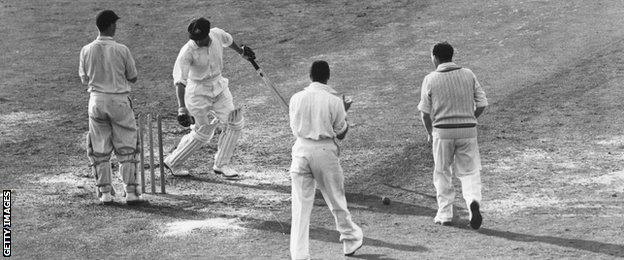Adil Rashid: Why England leg-spinner is one of a rare breed
- Published
- comments

Adil Rashid has taken 415 first-class wickets at an average of 34.22
Adil Rashid has had a mixed introduction to Test cricket with the ball, to say the least.
The England leg-spinner took 0-163 in the first innings of the opening Test against Pakistan - the worst figures by a debutant, external - but claimed 5-64 in the second innings as his side almost pulled off a remarkable victory.
Defeat in the second Test was notable for Rashid's heroics with the bat, although he managed only 1-84 and 1-107 with his strongest suit.
Ex-England captain Michael Vaughan has said: "Now we have a bit of mystery in the side, someone who can bring our attack to life."
With his final-day display in Abu Dhabi, Rashid became the first England leg-spinner to take five wickets in a Test since 1959.
Why have successful leg-spinners been so rare? And why do so few English players even bother with the skill?
'Bowling leg-spin is the hardest job in cricket'
Leg-spin involves spinning the ball away from a right-handed batsman, external using a full flick of the wrist and fingers. It allows a lot of spin to be put on the ball, but it is difficult to do with any accuracy.
"Leg-spin is by far the hardest thing to do in cricket," says former England bowler Graeme Swann. "The skill level is above and beyond anything else. It is just too hard to be consistent."
The technical demands do not end there. There are several variations, including the googly - which Rashid is good at bowling - involving turning the wrist so the ball comes out of the back of the hand and spins towards the right-hander rather than away.

Shane Warne took 1,001 wickets in international cricket
Then there is the bouncier top-spinner and also the flipper, which skids on to the batsman.
The bowler's aim is to make all those deliveries look as similar as possible when leaving the hand, so the batsman does not know which way the ball will turn.
Australia's Shane Warne was a master of these skills and arguably the greatest bowler - not simply leg-spinner - of all time.
He was responsible for the 'Ball of the Century', external to England's Mike Gatting in the 1993 Ashes, when the ball swerved towards the leg side, pitched outside leg stump and spun sharply to hit off stump. Leg-spin has never looked quite the same since.
No positive spin on England statistics
Warne is the most prolific leg-spinner in Test history, taking 708 Test wickets, external at an average of 25.41 during a glittering career that ended in 2007.
Doug Wright, England's most prolific exponent, managed 108 - but his last Test was in 1951.
In recent times, Ian Salisbury took 20 wickets in 15 Tests at 76.95 apiece from 1992-2000. Chris Schofield was discarded after two games without a wicket in 2000. Scott Borthwick was jettisoned after playing the final match of England's 5-0 Ashes whitewash in 2014-15, having taken four wickets at 20.50.
Borthwick was the first England leg-spinner to claim an Ashes wicket since Bob Barber in 1968.
And before Rashid, the last England leg-spinner to take five wickets in an innings was Lancashire's Tommy Greenhough - 56 years ago.
England's most successful Test leg-spinners | |||
|---|---|---|---|
Wickets | Average | Career | |
Doug Wright | 108 | 39.11 | 1938-51 |
Alf 'Tich' Freeman | 66 | 25.86 | 1924-29 |
Walter Robins | 64 | 27.46 | 1929-37 |
Len Braund | 47 | 38.51 | 1901-08 |
Ian Peebles | 45 | 30.91 | 1927-31 |
Was it always this bad?
No. English cricket invented leg-spin and Lancashire's AG Steel is regarded as the first bowler to take a Test wicket using an overarm leg-break.
Middlesex's Bernard Bosanquet popularised the googly in the 1903-04 Ashes and leg-spinners were common in county cricket after World War One.
Kent's Alf 'Tich' Freeman took at least 200 wickets eight seasons in a row, while Warwickshire's Eric Hollies - who dismissed Sir Donald Bradman in his final Test innings - Derbyshire's Tommy Mitchell, Lancashire's Richard Tyldesley and Surrey's Percy Fender were prolific.
In 1930, Middlesex fielded five England leg-spinners in the same side - Greville Stevens, Ian Peebles, Jim Sims, Jack Hearne and Walter Robins - but at Test level leg-spinners got few chances.
Freeman, who finished his career with 3,776 wickets, played only 12 Tests.

Sir Donald Bradman is bowled by Eric Hollies in his final Test innings in 1948. It left him with a career average of 99.94.
Australian leg-spinner Bill O'Reilly said English batsmen were so poor at playing leg-spin that the authorities "decided to destroy it".
In 1946 a rule was brought in allowing the new ball to be taken after fewer overs, and in the 1950s counties were asked to prepare green, seaming 'result' pitches. Both moves favoured quicker bowlers.
The introduction of one-day cricket in the 1960s, when bowlers' priorities shifted from taking wickets to not conceding runs, is seen as another reason behind leg-spinners' demise.
By the early 1980s there were no full-time practitioners in first-class cricket; the last English leg-spinner to take 1,000 first-class wickets, Robin Hobbs, retired in 1981.
"Hobbs would have been a typical county spinner if he had been born 60 years earlier," wrote Christopher Martin-Jenkins. "As it happened, he was for much of his career unique."
'It was like something dropped from the moon'
Salisbury made his Test debut in 1992, becoming the first leg-spinner to represent England since Hobbs.
Although he took five wickets in the match, there was much ignorance about what he was doing.
When Salisbury joined the England set-up, wicketkeeper Jack Russell was worried about how to pick his googly, having hardly seen it in county cricket.

Ian Salisbury's 15 Tests spanned eight years
To help Russell, Salisbury was instructed to turn in one direction at the start of his run-up before he bowled the leg-break and the other before he bowled a googly. "That messed me up," Salisbury said.
Hobbs said Salisbury's arrival on the scene was "like something had dropped from the moon".
England picked and dropped Salisbury, who had the misfortune to play at the same time as Warne, several times over the next eight years.
"I didn't have the same raw talent to be as good as Shane Warne but I could have been 50% better than I was," said Salisbury.
How have England tried to solve the problem?
The England and Wales Cricket Board (ECB) set up a recruitment and training programme for leg-spinners in 1999, with the aim to have one in the Test team by 2007.
Those picked to take part in the scheme went to live with Warne's coach, the ex-Australia bowler Terry Jenner, in Adelaide. Rashid was among them.
Borthwick, Yorkshire's Mark Lawson and Somerset's Michael Munday broke through, but only Borthwick remains a county player - and he operates more as a batsman than a frontline spinner.
Munday, who took 86 wickets at 29.46 in first-class games, was released by Somerset in 2010, aged 25. Lawson, who took 52 wickets at 43.82, last played a County Championship match in 2009; he was 23.

"We clicked instantly," Shane Warne said of Terry Jenner, his coach and mentor, who died in 2011
English pitches, which do not offer as much bounce as Australian surfaces or as much turn as those in India, have been blamed.
But overseas leg-spinners, including Warne, Kumble and Mushtaq Ahmed, have taken hundreds of wickets in county cricket.
"The main problem is nothing to do with pitches or conditions," Lawson said., external "It's that we want immediate success.
"As a leg-spin bowler, even up to the age of 28 or 29 you're still going to have good years and bad years."
Even Rashid had to wait seven years to make his Test debut after first being called up to the squad in 2008.
The curious case of the hypnotised leg-spinner
In 2005, an out-of-sorts club leg-spinner approached Jamie Barker and Marc Jones,, external psychologists at the University of Staffordshire, for help.
They prescribed a course of hypnosis. This involved the bowler taking 100 deep breaths and imagining walking down a staircase and into a room containing cards with slogans such as "Express yourself" and "Be decisive".
The bowler carried out this self-hypnosis, even locking himself in a toilet cubicle before the start of play.
Although he recorded better figures over the next couple of years, the experiment was not continued. Yet Barker is convinced leg-spinners in particular require extra help to deal with the demands of their role, such is their rarity.
Can Rashid inspire a new generation?
In 2015, spinners of all types bowled only 21.5% of overs in English county cricket. The ECB's spin coach, Peter Such, is overseeing a development programme, external designed to create a larger pool of players who could go on to play for England.
Warne has offered to work with Rashid,, external describing him as a "pretty impressive kid". But he says captains must learn how to set fields for young spinners and cope with the inconsistencies of a potential match-winner.
Trevor Bayliss, the Australia-born England coach, was asked after the first Test why England had been lacking a leg-spinner for so long.
"Usually they are a little more expensive and maybe not quite as accurate," he said. "Maybe English cricket over the last few years has had a bit too much of an emphasis on not going for runs. My belief is that the best way to stop the runs is by taking wickets."

Mason Crane has represented England at under-19 level
There are some signs of a new generation coming through. Eighteen-year-old Mason Crane - described by Such as "very talented", external - took five wickets on his championship debut for Hampshire this summer.
Josh Poysden, now 24, made his Warwickshire debut this year, impressing Warne and former England captain Michael Atherton with his action.
Poysden took a catch as a substitute fielder in the third Ashes Test at Edgbaston. Whether he and Crane will follow Rashid into the full England team remains to be seen.
Justin Parkinson is the author of The Strange Death of English Leg Spin: How Cricket's Finest Art Was Given Away.
- Published27 October 2015

- Published28 October 2015

- Published19 November 2015

- Published18 October 2019

- Published15 May 2018
